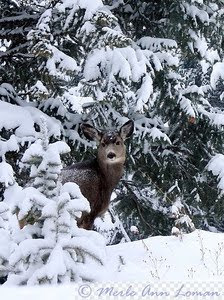
Small elk herd in December 2008 (Photo by Merle Ann Loman)
This is a photo journal of a particular group of elk in the Bitterroot Valley. The photos document movements in almost every month of the year and were collected over a period of 3 years. This group moves about on private and adjacent public land. It has been seen as one big group, or herd, of up to a few hundred, in smaller groups of around 50, and sometimes as individuals alone. The bigger bulls are the most elusive so these photos are of cows, calves and some young bulls.
The photo journal begins in November at the end of breeding and general hunting season. For the winter months the elk have stayed mostly on private land that is very near Forest Service land. They seem to know that these private landowners don’t allow hunting and they are relatively safe there. They adapt well and their simple needs of food, water, space, shelter and a degree of safety are met.

Lone elk in April (Photo by Merle Ann Loman)
Toward the end of March, the photos show them moving with the snow line up in elevation and towards Forest Service land. The newly exposed vegetation is tender and full of nutrition. The older bulls go first, then the younger bulls, cows and calves. The pregnant cows begin migrating towards higher elevations looking for thicker brush and timber. They need secure areas to give birth.
When ready to give birth, usually during mid-May through late-June, a cow will move to an area that elk seldom visit to avoid predators and protect her calf. The calf will weigh about 35 pounds and has no odor. In a couple of weeks the calf is stronger and they will reunite with other cows and calves – safety in numbers.
The bull elk shed their antlers in the winter and by May they begin growing again. In some of the photos you will see little "buttons" on their heads between their ears. In the beginning as the antlers grow, the bone will be covered by skin with numerous blood vessels (velvet). By fall the velvet dries and the bulls use rub trees to scrape it off. See a photo of a rub tree in the slideshow.

Elk nursery group with a few "button bulls" (Photo by Merle Ann Loman)
During the summer elk form nursery groups where the cows take turns “tending” the calves allowing the other cows graze and rest. Calves nurse up to nine months and by fall can weigh up to 225 pounds or more.
The hottest month in the Bitterroot is August. The elk stay at higher elevations deep in the timber and draws trying to stay cool. Their movements are often at night. In September the rut (mating) begins and the bulls gather their harems, or groups of cows. The quiet of the morning or evening will be pierce with the distinct bugle of a bull as he tries to impress his cows or warn other bulls to stay away. And the cycle begins again.
Play audio (wav format) – hear the sound of a bull bugling.
Rocky Mountain Elk Foundation – Elk through the seasons
Kings Outdoor World – All about Antlers
Merle’s SmugMug photo site – Elk photos through the seasons


